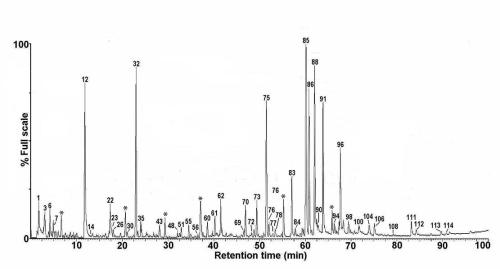Chemistry plays a pivotal role in innumerable research fields, including those related to volatile compounds found throughout nature. One example is in unravelling the mechanisms by which animals communicate through semiochemicals, a term that originates from the Greek word semeon, which means ‘signal’ or ‘to sign’. This encompasses chemical signalling molecules that have evolved for members of the same species or different species to communicate with one another, eliciting a specific behaviour in the receiver. Such signalling molecules can act as pheromones (semiochemicals) associated with sex, territory, recognition, food trail, aggregation, alarm and many others. Pheromones have been used for many decades to manage and control insect pests, but they also play an important role in many mammalian species.
The study of territorial marking fluid pheromones in big cats, such as tigers and leopards, has provided information that may aid in their conservation. Tigers use many different forms of communication, including sound and visual cues, but because they are mostly nocturnal and solitary creatures, they also use semiochemical communication. Urine mixed with scent gland secretion and faeces are the main vectors of these semiochemical messages, sprayed or marked on conspicuous objects. This is an effective way to communicate how recently a tiger has passed by, its gender and, in the case of a female, whether she is sexually receptive.
The Bengal tiger, Panthera tigris tigris, is a subspecies of tiger found throughout India and Indochina. My previous research aimed to understand the chemical composition of Bengal tiger territorial marking fluid (Burger B.V., Viviers M.Z., Bekker J.P.I., Le Roux M., Fish N., Fourie W.B., Weibchen G. J. Chem. Ecol. 2008, vol. 34, pp. 659–71) by using gas chromatography–mass spectrometry (GC-MS). We found that the territorial marking fluid of male tigers consists of a urine fraction and a small quantity of lipid material. We identified a rich mixture of 98 volatile organic compounds (VOCs) (see chromatogram p. 39), mostly consisting of alcohols, aldehydes, ketones, unbranched acids, esters and lactones. The dominant contribution of a select few VOCs present in the headspace of the marking fluid suggested that these compounds may be important constituents of the semiochemical message. Interestingly, although the lipid fraction made up only a small portion of the total volume of the marking fluid, it contained the largest quantity of VOCs. This suggested that the lipid fraction may act as a controlled-release carrier for the semiochemicals present in the marking fluid. We recorded the tiger’s behaviour when exposed to certain chemical constituents identified in the marking fluid. The gamma-lactone (S)-(+)-(Z)-6-dodecen-4-olide appeared to be an important compound for territorial marking behaviour by the male tiger, which reacted strongly to this compound and displayed distinct marking behaviour. This knowledge could be used in tiger conservation programs to improve the monitoring of numbers in the wild. By installing counting stations that display synthetic pheromones, tigers could be enticed to ‘report’ for counting and ‘mark’ over the synthetic pheromones.
Pheromone research and wine aroma and flavour research may seem worlds apart, but the same science can unravel the chemical information and analytical techniques used to elucidate tiger communication semiochemicals and key aroma and flavour characteristics of wine – many foods and beverages contain a diverse array of volatiles. By using GC-MS-based analytical techniques, we have come to recognise that most of the volatile chemical compounds identified in the territorial marking fluid of tigers are also present as volatile compounds in a wine’s aromatic bouquet. In fact, most of the hundreds of volatile aroma compounds identified in wine (including alcohols, aldehydes, ketones, esters, terpenes, norisoprenoids, phenols and lactones), in concentrations ranging from a few nanograms to hundreds of milligrams per litre, have also been identified in tiger marking fluid.
Interestingly, lactones important for tiger marking fluid are also implicated in wine stone fruit aroma (see June–August issue, p. 40). Lactones such as g-nonalactone have been found to be important for the stone fruit aroma of botrytis Semillon wine (Siebert T.E., Barter S.R., de Barros Lopes M.A., Herderich M.J., Francis L. Food Chem. 2018, vol. 256, pp. 286–96). Such is the natural world of volatiles, lactones are not unique to tigers and wine, but are also important for the sensory characters of fresh stone fruit such as peaches and apricots.
Many natural products, such as those in tiger urine and wine, contain the same volatile aroma compounds, but it is their concentrations and interactions with other compounds in a given matrix that is important. Volatile composition determines the final sensory impact and unique aroma that each natural product will have, and that applies to a multitude of wine styles or Bengal tiger semiochemicals.





